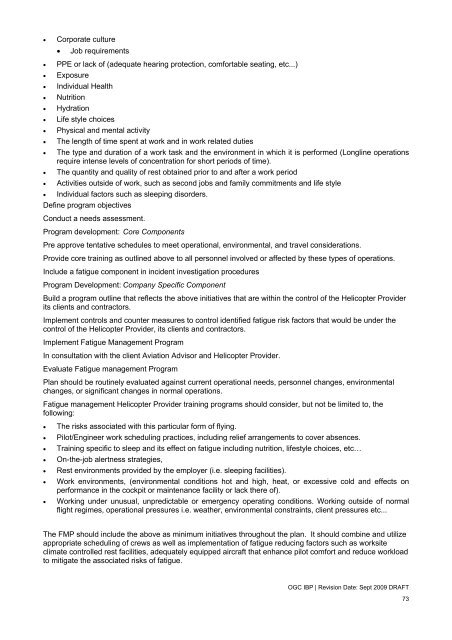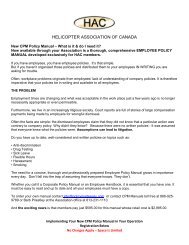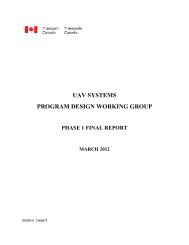HAC Oil & Gas IBP - Helicopter Association of Canada
HAC Oil & Gas IBP - Helicopter Association of Canada
HAC Oil & Gas IBP - Helicopter Association of Canada
Create successful ePaper yourself
Turn your PDF publications into a flip-book with our unique Google optimized e-Paper software.
Corporate culture Job requirements PPE or lack <strong>of</strong> (adequate hearing protection, comfortable seating, etc...) Exposure Individual Health Nutrition Hydration Life style choices Physical and mental activity The length <strong>of</strong> time spent at work and in work related duties The type and duration <strong>of</strong> a work task and the environment in which it is performed (Longline operationsrequire intense levels <strong>of</strong> concentration for short periods <strong>of</strong> time). The quantity and quality <strong>of</strong> rest obtained prior to and after a work period Activities outside <strong>of</strong> work, such as second jobs and family commitments and life style Individual factors such as sleeping disorders.Define program objectivesConduct a needs assessment.Program development: Core ComponentsPre approve tentative schedules to meet operational, environmental, and travel considerations.Provide core training as outlined above to all personnel involved or affected by these types <strong>of</strong> operations.Include a fatigue component in incident investigation proceduresProgram Development: Company Specific ComponentBuild a program outline that reflects the above initiatives that are within the control <strong>of</strong> the <strong>Helicopter</strong> Providerits clients and contractors.Implement controls and counter measures to control identified fatigue risk factors that would be under thecontrol <strong>of</strong> the <strong>Helicopter</strong> Provider, its clients and contractors.Implement Fatigue Management ProgramIn consultation with the client Aviation Advisor and <strong>Helicopter</strong> Provider.Evaluate Fatigue management ProgramPlan should be routinely evaluated against current operational needs, personnel changes, environmentalchanges, or significant changes in normal operations.Fatigue management <strong>Helicopter</strong> Provider training programs should consider, but not be limited to, thefollowing:The risks associated with this particular form <strong>of</strong> flying.Pilot/Engineer work scheduling practices, including relief arrangements to cover absences.Training specific to sleep and its effect on fatigue including nutrition, lifestyle choices, etc…On-the-job alertness strategies,Rest environments provided by the employer (i.e. sleeping facilities).Work environments, (environmental conditions hot and high, heat, or excessive cold and effects onperformance in the cockpit or maintenance facility or lack there <strong>of</strong>).Working under unusual, unpredictable or emergency operating conditions. Working outside <strong>of</strong> normalflight regimes, operational pressures i.e. weather, environmental constraints, client pressures etc...The FMP should include the above as minimum initiatives throughout the plan. It should combine and utilizeappropriate scheduling <strong>of</strong> crews as well as implementation <strong>of</strong> fatigue reducing factors such as worksiteclimate controlled rest facilities, adequately equipped aircraft that enhance pilot comfort and reduce workloadto mitigate the associated risks <strong>of</strong> fatigue.OGC <strong>IBP</strong> | Revision Date: Sept 2009 DRAFT73









